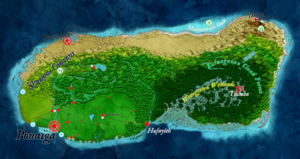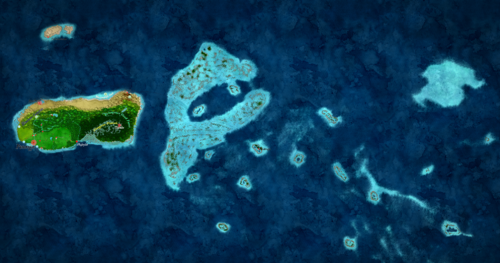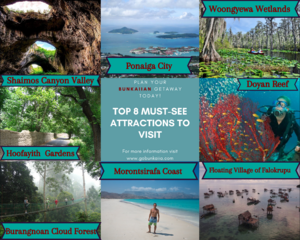Bunkaiia
Mazdakian People's Noocracy of Bunkaiia Wuàtouraïa Mastakei là Bàñkaïa | |
|---|---|
Emblem
| |
| Capital and largest city | Ponaiga |
| Official languages | Bunkaiian, Italian, English |
| Protected regional or minority languages | Doyani, Tulu, Pinoni Hebrew |
| Ethnic groups (2019) | |
| Religion (2019) |
|
| Demonym(s) | Bunkaiian |
| Government | Parliamentarian Theocratic-Noocracy |
| Legislature | Gouwul |
| Independence from The United Kingdom | |
• Declared | 1960's |
| Area | |
• Total | 7,594 km2 (2,932 sq mi) |
| Population | |
• 2020 estimate | 412,060 |
• 2010 census | 391.213 |
• Density | 51.5/km2 (133.4/sq mi) |
| Currency | Màrgareita (BMG) (BMG) |
| Time zone | UTC+04:00, D (Bunkaiia Time) |
| Date format | dd/mm/yyyy |
| Driving side | left |
| Calling code | +292 |
| Internet TLD | .bk |
Bunkaiia
Bunkaiia [/ˈbəŋkaɪˈja/ BUNG-kay-yah] (alternatively written as Bunkaïa) , officially the Mazdakian People's Noocracy of Bunkaiia (Shibung: Wàtouraïa Mastakei là Bàñkaïa), is an archipelagous country in the northern Indian Ocean. Situated North of Seychelles and South-East off of the Yemeni island of Socotra.
1 Etymology
2 Geography & Climate
2.1 Geography
2.2 Climate
2.3 Weather
3 History
3.1 Prehistory
3.2 Early Austronesians
3.3 Mazdakite Sanctuary
3.4 Swahilification
3.5 Colonial Wars
3.6 Modern history
3.6.1 Italian Colonization
3.6.2 British Liberation
3.6.3 Independence
3.4.6 2000–present
4 Government & Politics
4.1 Government
4.2 Political Parties
4.3 Administrative Districts
4.4 Cities
5 Economy
5.1 Tourism
5.1.1 Ecotourism
5.1.2 Nightlife
5.1.3 Sextourism
5.2 Agriculture
5.2.1 Aquaculture
5.2.2 Terrestrial Agriculture
5.2.3 Cavern Agriculture
5.3 Industry
5.3.1 Mining
5.3.3 Sea Salt
5.3.6 Horticulture
5.3.7 Construction
5.4 Manufacturing
5.5 Transportation
6 Demographics
6.1 Ethnic groups
6.2 Religions
6.3 Languages
7 Culture
7.1 Cuisine & Foodways
7.2 Sex & Sexuality
7.3 Art & Music
7.3 Gardening
7.5 Festivals & Holidays
7.6 Architecture
8 Education
9 Flora & Fauna
9.1 Flora
9.2 Fauna
9.3 Invasive Species
10 International Relations
10.1 Sister Cities
1. Etymology
Do the multicultural and ancient origins, the etymology of Bunkaiia is of uncertain origin. In the notes to his translation of the Periplus of the Erythraean Sea, G.W.B. Huntingford remarks that the names of Bunkaiia/Pankhaia is clearly not of Greek in origin.
There are the etymological interpretations that are hotly contested.
- The First is from Middle Persian بندر (bandar) meaning "Port/Enclosed area" and Persian 𐬔𐬀𐬌𐬌𐬊 [ˈɡaɪ.o] meaning “life”, thereby leading to the interpretation of "Port of Life", as it's ports were invaluable for the long-distance trade experditions taking place in Antiquity along the Monsoon trade routes.
- The Second is from Malayo-Polynesian banua meaning "land/village/house/country/sky/heaven" and kaya meaning force/wealth/power, thereby leading to the interpretation of "Land of Wealth", as its geographic location along the trade routes surely economically benefitted the native populace in the eyes of the intrepid traders.
- The Third (and most controversially) is from Proto-Ongan *baŋnan meaning "flat surface" and kaya meaning mother.
2. Geography & Climate
2.1 Geography
The archipelago can easily be split into three main groups.
- The main island of Bunakiia, which contains the Woongyewa Wetlands (a large mangrove-swamp-marsh bio-hotspot) that seasonally floods and dries, the constantly humid cloud forest along the Southern slopes of the Eastern mountains, the Western canyons and South-eastern plateau, the central forests and the northern desiccated coast. For a relatively small island it has an astonishing array of geographic diversity. Most of the population lives rather dispersed in the Western portion of the island with the only settlements in East being the floating city of Tsumba and the coastal city of Doleish.
- The pair of Hashadoomani islands in the North are extremely arid and sparsely populated but was once home to an independent Nestorian Christian theocracy.
- The 300+ Doyan islets & atolls are sparsely populated by the native Austronesian Doyans and are known for their stilted or "floating" villages. The beaches, inlets, lagoons and reefs are major attractions for ecotourists and sea turtles and dugongs are commonly spotted.
3. History
The Bunkaiian islands were uninhabited by humans throughout most of recorded history. Human settlement of Bunkaiia's islands (along with neighbouring Seychelles and Madagascar) occurred between 350 BC and 550 AD Austronesians, arriving on outrigger canoes from Southern Borneo. The Doyanian community, mostly located on the Doyan atolls and islets in the East are the modern day direct descendants of this initial migration.
Possibly prior to the firm settlement by the early Austronesians, the main island of Bunkaiia (along with Socotra) played a role as a stopover island for early cross-Indian Ocean traders sailing along the Monsoon winds. Ancient Egyptian texts mention a mountainous island in the middle of the ocean known for having fresh water and readily available sea salt, rare commodities during merchant expeditions to either India, Mesopotamia or East Africa. As knowledge of the island became more widespread, various other nations soon sent expedicionary forces to take control of the island. Eventually the Yemeni client state of Sassanid Persia's interest won out in the early 500's CE.
In the 530's, Khosrow I's persecution of the communist and free-loving Mazdakites led to the fleeing of hundreds of recently converted liberated temple slaves, prostitutes, prisoners of war and impoverished folk. Many fled to the Caucasus, the Caspian coast, Arabia, and Yemen. Yemen was especially popular as its burgeoning trade ports and distance from the now-hostile Persian central state offered some refuge. Sometime during the 6th century, the Mazdakite refugees found their way to the main island of Bunkaiia. Nestorian Assyrians, Yemeni Jews and others would also eventually settle portions of the island in due time, possibly as a result of commerce or fleeing from religious persecution as well (either Zoroastrian, Christian or Islamic).
Between 7th and 8th centuries, the Christian kingdom of Ethiopia and the Arab, Somali and Swahili coastal states began trading in Cushitic and Bantu slaves extracted from the hinterlands pf Eastern Africa. Escaped and runaway slaves often fled or tried to flee to the vehemently anti-slavery Bunkaiia, where they could be free. The journey was ardous and risky and many never made it. Despite the risks though, the island's initialy primarily Austronesian-Persian population became strongly Bantufied. The language of Šibàñ began as a creole between the merger of these three highly distinct cultures.
European interest began....
5.1 Tourism



